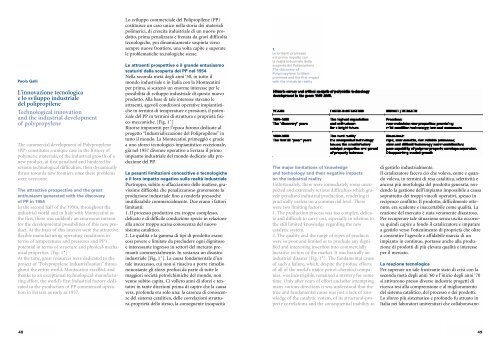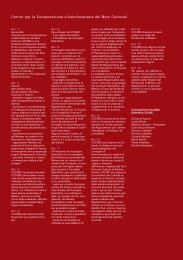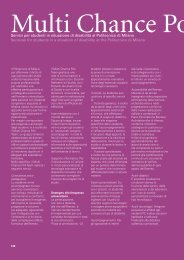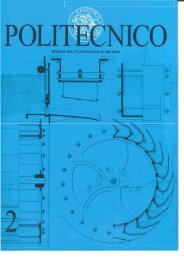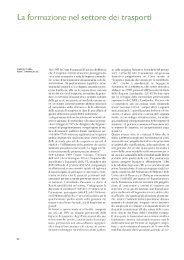Scarica il PDF (1959KB) - Rivista Politecnico - Politecnico di Milano
Scarica il PDF (1959KB) - Rivista Politecnico - Politecnico di Milano
Scarica il PDF (1959KB) - Rivista Politecnico - Politecnico di Milano
Create successful ePaper yourself
Turn your PDF publications into a flip-book with our unique Google optimized e-Paper software.
Paolo Galli<br />
L’innovazione tecnologica<br />
e lo sv<strong>il</strong>uppo industriale<br />
del poliprop<strong>il</strong>ene<br />
Technological innovation<br />
and the industrial development<br />
of polypropylene<br />
The commercial development of Polypropylene<br />
(PP) constitutes a unique case in the history of<br />
polymeric materials, of the industrial growth of a<br />
new product, at first penalised and hindered by<br />
serious technological <strong>di</strong>fficulties, then dynamically<br />
thrust towards new frontiers once these problems<br />
were overcome.<br />
The attractive prospective and the great<br />
enthusiasm generated with the <strong>di</strong>scovery<br />
of PP in 1954<br />
In the second half of the 1950s, throughout the<br />
industrial world and in Italy with Montecatini as<br />
the first, there was suddenly an enormous interest<br />
for the developmental possib<strong>il</strong>ities of this new product.<br />
At the basis of this interest were the attractive,<br />
flexible manufacturing operating con<strong>di</strong>tions in<br />
terms of temperatures and pressures and PP’s<br />
potential in terms of structure and physical-mechanical<br />
properties. [Fig. 1 ]<br />
At the time, great resources were de<strong>di</strong>cated to the<br />
project of “Polypropylene Industrialisation” throughout<br />
the entire world. Montecatini excelled, and<br />
thanks to an exceptional technological-manufacturing<br />
effort, the world’s first industrial factory de<strong>di</strong>cated<br />
to the production of PP commenced operation<br />
in Ferrara as early as 1957.<br />
48<br />
Lo sv<strong>il</strong>uppo commerciale del Poliprop<strong>il</strong>ene (PP)<br />
costituisce un caso unico nella storia dei materiali<br />
polimerici, <strong>di</strong> crescita industriale <strong>di</strong> un nuovo prodotto,<br />
prima penalizzata e frenata da gravi <strong>di</strong>fficoltà<br />
tecnologiche, poi <strong>di</strong>namicamente sospinta verso<br />
sempre nuove frontiere, una volta capite e superate<br />
le problematiche tecnologiche stesse.<br />
Le attraenti prospettive e <strong>il</strong> grande entusiasmo<br />
scaturiti dalla scoperta del PP nel 1954<br />
Nella seconda metà degli anni ‘50, in tutto <strong>il</strong><br />
mondo industriale e in Italia con la Montecatini<br />
per prima, si scatenò un enorme interesse per le<br />
possib<strong>il</strong>ità <strong>di</strong> sv<strong>il</strong>uppo industriale <strong>di</strong> questo nuovo<br />
prodotto. Alla base <strong>di</strong> tale interesse stavano le<br />
attraenti, agevoli con<strong>di</strong>zioni operative impiantistiche<br />
in termini <strong>di</strong> temperature e pressioni, <strong>il</strong> potenziale<br />
del PP in termini <strong>di</strong> struttura e proprietà fisico-meccaniche.<br />
[Fig. 1 ]<br />
Risorse imponenti per l’epoca furono de<strong>di</strong>cate al<br />
progetto “Industrializzazione del Poliprop<strong>il</strong>ene” in<br />
tutto <strong>il</strong> mondo. La Montecatini primeggiò e grazie<br />
a uno sforzo tecnologico-impiantistico eccezionale,<br />
già nel 1957 <strong>di</strong>venne operativo a Ferrara <strong>il</strong> primo<br />
impianto industriale del mondo de<strong>di</strong>cato alla produzione<br />
del PP.<br />
Le pesanti limitazioni conoscitive e tecnologiche<br />
e <strong>il</strong> loro impatto negativo sulla realtà industriale<br />
Purtroppo, subito si affacciarono delle inattese, gravissime<br />
<strong>di</strong>fficoltà che penalizzarono gravemente la<br />
produzione industriale fino a renderla pressoché<br />
inut<strong>il</strong>izzab<strong>il</strong>e commercialmente. Due erano i fattori<br />
limitanti:<br />
1. Il processo produttivo era troppo complesso,<br />
delicato e <strong>di</strong> <strong>di</strong>ffic<strong>il</strong>e conduzione specie in relazione<br />
alla ancor troppo scarsa conoscenza del nuovo<br />
sistema catalitico.<br />
2. La qualità e la gamma <strong>di</strong> tipi <strong>di</strong> prodotto erano<br />
così povere e limitate da precludere ogni <strong>di</strong>gnitoso<br />
e interessante ingresso in settori del mercato premianti<br />
commercialmente. In sostanza un <strong>di</strong>sastro<br />
industriale [Fig. 1 ]. La causa fondamentale d’un<br />
tale insuccesso, cui non si riusciva a porre rime<strong>di</strong>o<br />
nonostante gli sforzi profusi da parte <strong>di</strong> tutte le<br />
maggiori società petrolchimiche del mondo, non<br />
venne subito capita. Ci vollero anni <strong>di</strong> sforzi e tentativi<br />
in tante <strong>di</strong>rezioni prima <strong>di</strong> capire che la causa<br />
vera, profonda era solo una: la carenza <strong>di</strong> conoscenze<br />
del sistema catalitico, delle correlazioni struttura-proprietà<br />
dello stesso, la conseguente incapacità<br />
1.<br />
Le br<strong>il</strong>lanti promesse<br />
e <strong>il</strong> primo impatto con<br />
la realtà industriale della<br />
scoperta del Poliprop<strong>il</strong>ene<br />
The <strong>di</strong>scovery of<br />
Polypropylene: br<strong>il</strong>liant<br />
promises and the first impact<br />
with the industrial reality<br />
The major limitations of knowledge<br />
and technology and their negative impacts<br />
on the industrial reality<br />
Unfortunately, there were imme<strong>di</strong>ately some unexpected<br />
and extremely serious <strong>di</strong>fficulties which gravely<br />
penalised industrial production, rendering it<br />
practically useless on a commercial level. There<br />
were two limiting factors:<br />
1. The production process was too complex, delicate<br />
and <strong>di</strong>fficult to carry out, especially in relation to<br />
the st<strong>il</strong>l limited knowledge regar<strong>di</strong>ng the new<br />
catalytic system.<br />
2. The quality and the range of types of products<br />
were so poor and limited as to preclude any <strong>di</strong>gnified<br />
and interesting insertion into commercially<br />
lucrative sectors of the market. It was basically an<br />
industrial <strong>di</strong>saster [Fig. 1 ]. The fundamental cause<br />
of such a fa<strong>il</strong>ure, which, despite the profuse efforts<br />
of all of the world’s major petrol-chemical companies,<br />
was incorrigible, remained a mystery for some<br />
time. Only after years of effort and after attempting<br />
many various <strong>di</strong>rections it was understood that the<br />
true and fundamental cause was just a lack of knowledge<br />
of the catalytic system, of its structural-property<br />
correlations and the consequential inab<strong>il</strong>ity to<br />
<strong>di</strong> gestirlo industrialmente.<br />
Il catalizzatore faceva ciò che voleva, come e quando<br />
voleva, in termini <strong>di</strong> resa catalitica, selettività e<br />
ancora più morfologia del prodotto generata, rendendo<br />
la gestione dell’impianto impossib<strong>il</strong>e a causa<br />
soprattutto dei troppi vincoli operativi, spesso in<br />
reciproco conflitto. Il prodotto, <strong>di</strong>ffic<strong>il</strong>mente ottenuto,<br />
era scadente e inaccettab<strong>il</strong>e come qualità. La<br />
reazione del mercato è stata veramente <strong>di</strong>sastrosa.<br />
Per recuperare tale situazione senza uscita occorreva<br />
quin<strong>di</strong> capire a fondo <strong>il</strong> catalizzatore e imparare<br />
a gestirlo verso l’ottenimento <strong>di</strong> proprietà che oltre<br />
a consentire l’agevole e affidab<strong>il</strong>e marcia <strong>di</strong> un<br />
impianto in continuo, portasse anche alla produzione<br />
<strong>di</strong> prodotti <strong>di</strong> più elevata qualità e interesse<br />
per <strong>il</strong> mercato.<br />
La reazione tecnologica<br />
Per superare un tale frustrante stato <strong>di</strong> crisi con la<br />
seconda metà degli anni ‘60 e l’inizio degli anni ‘70<br />
si attivarono presso <strong>di</strong>verse industrie progetti <strong>di</strong><br />
ricerca tesi alla comprensione e al miglioramento<br />
del sistema catalitico, del processo e dei prodotti.<br />
Lo sforzo più sistematico e profondo fu attuato in<br />
Italia nei laboratori universitari che collaboravano<br />
49


